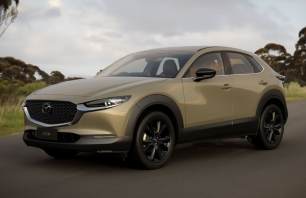Put simply, the MX-30 is about as practical as a sports coupe, which is a feat given it has the footprint and height of an SUV.
It starts with those clamshell doors. Sure, they look amazing, but they’re annoying to open because the handle is on the inside, so you have to open the front doors before you can open the rear ones. At best this costs you time when you’re just trying to load objects, pets, or kids, at worst it makes the rear of the cabin nearly impossible to access in a tight car park.
Even in my unit parking spot, I could barely access the rear seats, making it especially annoying when I just wanted to chuck a bag in the rear footwell.
Even if you don’t have trouble getting an adult back there, space is limited. Behind my own driving position, my knees were up against the seat in front, and while I had plenty of headroom, it feels a bit claustrophobic, thanks to the tiny windows and high beltline.
I’ll hand some credit to the commitment to this car’s design, though, the odd carpet trims continue into the rear doors, and there's even a plush padded surface for your elbows on either side. Nice touch. The seats also feel unusually low and sporty for an SUV, particularly an electric one.
As if it couldn’t be more clear that this car has the intention of being some sort of sports coupe, the front seats are lovely. Comfortable, supportive, and with plenty of soft trims throughout the cabin, I felt as though I had plenty of room here. The raised console design means the multimedia functions and toggles were easy to reach and use, and while the climate functions are somewhat awkwardly placed on a touch panel, at least they were set and forget most of the time.
There’s a tactile dial for volume control, and although the multimedia interface is dial-based rather than touch, Mazda’s system is one of the easiest to use once you get used to it.
There’s a large storage area under the centre console, hosting two USB ports and a household power outlet, and atop that there’s a cork-finished tray, which flips up to reveal dual bottle holders in the centre. Behind this there’s a small armrest console box, trimmed in the same plush padding as the doors and seats. Front occupants can also make use of small pockets in the doors and a glovebox.
Unlike some electric cars, the MX-30 doesn’t score a ‘frunk’, which seems like a wasted opportunity because the engine bay is half empty. Serviceable items look incredibly easy to access because of this, with liquid tanks and coolant hoses on display, but I can’t help but feeling Mazda could have put a small storage space here with some packaging trickery. It’s equally possible that there’s a crash-safety consideration, however.
Moving to the boot, and unfortunately there’s a small-hatch-sized 311 litres on offer, because there’s also next to no underfloor space, and you’ll have to store your charging cables in there, too, further reducing the space. With the cable bags strapped in place, the boot fit our largest (124L) CarsGuide travel case with little extra room to spare. It’s weekender luggage space at best, but then I suppose you won’t be able to go away for long with the range on offer anyway…

